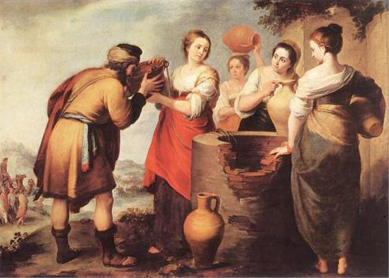Levirate marriage is one response to the challenges that arose when an Israelite man died leaving a widow but no children. What becomes of a widow with no children to care for her? What becomes of a man’s “name” and property in the absence of direct heirs? Levirate marriage, as described in Deut 25:5-10, offers a solution to both questions: Let the dead man’s brother marry the widow and let the children, or at least the first child of this union, be “accounted” to the deceased.
In Ruth 1, Naomi references levirate marriage as she urges her daughters-in-law, Ruth and Orpah, to return to their families of origin: “Do I still have sons in my womb that they may become your husbands? … Even if I should have a husband tonight and bear sons, would you then wait until they were grown?” (Ruth 1:11-13). Naomi argues that even if she could bear sons who could enter into levirate unions, it would be unreasonable to ask Ruth and Orpah to wait until these sons were old enough to marry. Because Naomi’s sons are dead and she has no hope of bearing others, her daughters-in-law are free of any obligation to their husbands.
Scholars disagree as to whether the events described in Ruth 4 relate to the institution of levirate marriage (also known simply as “levirate”). Though according to Boaz the marriage will “maintain the dead man’s name on his inheritance” (Ruth 4:10), the marriage of Ruth and Boaz does not seem mandated by the law in Deuteronomy, given that Boaz is not Ruth’s brother-in-law, nor does the genealogy in Ruth 4 credit Ruth’s son to her deceased husband’s line. In some ways, the transactions described resemble the redemption process for property outlined in Lev 25:25, where male relatives buy back property an impoverished kinsman was forced to sell. However, there is no indication in Leviticus that redemption of a kinsman’s property is in any way connected to marriage with the kinsman’s widow.
Ironically, biblical texts offer more evidence of levirate’s potential failures than of its successes. In Gen 38, Onan refuses to impregnate his widowed sister-in-law Tamar; after Onan’s death, a third brother is withheld from Tamar. Only by deceiving her father-in-law Judah does Tamar obtain the children she wants—from her father-in-law, not her brother-in-law! Deuteronomy itself acknowledges that a man who refuses to marry his brother’s widow can be publicly shamed but is then released from his obligation to the widow and his dead brother.
Although levirate is a strategy for preserving a man’s legacy and property by producing a posthumous heir for him, biblical men—Onan, Judah, the reluctant brother-in-law in Deut 25—seem to resist obligations to deceased kinsmen and their widows. It is the women—Tamar, Naomi, and Ruth—who seek to reintegrate widows into their late husbands’ families and pursue the engendering of children through levirate or levirate-like unions. Perhaps despite the Hebrew Bible’s emphasis on the aim of providing a “name” for a man who has died without children, the true goal of levirate was viewed as the protection of widows, a goal more passionately valued and pursued by women than men.





